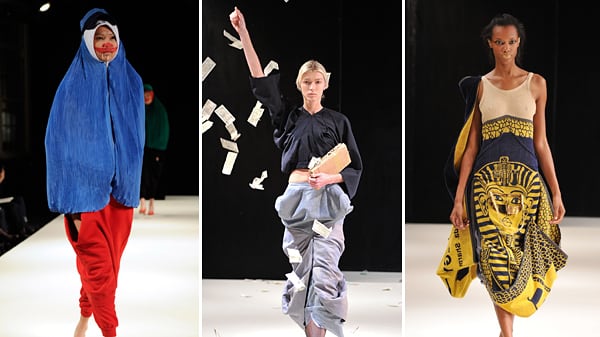
It has been nearly a decade since the designer Miguel Adrover showed a collection under his own name in New York, a city where he once set the fashion industry abuzz with his exquisite tailoring, audacious recycling, and willingness to inject politics and social commentary into a runway presentation. During the height of his critical success—or at least editorial attention—Adrover was known for repurposing garments, most famously old Burberry trench coats, and transforming them into something oftentimes more beautiful than they were before.
He also had the prescient yet unfortunate timing of designing a collection inspired by the Middle East—complete with nods to the burqa and the hijab—in the months just before the Sept. 11 terrorist attacks. It was a poetic and open-minded presentation. But in the aftermath of 9/11 with this country’s emotions running high, that collection never made it into production and signaled the beginning of his business’s demise.
But after a hiatus from the white-hot center of the fashion industry, the Majorcan-born designer returned to the runway Saturday night—looking a bit like a nomad who’d sprinted in from the wilderness with long, unkempt hair, a hermit’s beard, and a frame so thin it looked almost breakable. He brought with him a collection that was inspired by the fanciful notion that a trunk of clothes had fallen from an airplane into the Amazon and the rainforest inhabitants, mystified by such things as men’s suits, T-shirts, leather gloves, and sweaters, slipped them on upside down, inside out, and in other unorthodox ways.
Adrover’s parade of models wore blazers as skirts, turned gloves into shoes (with the middle digit extended in a potty-mouth gesture) and donned T-shirts as skirts that hung low on their hips. The work shirts of the blue-collar shift were given the same amount of respect—or lack of it—as the pinstripes of bankers. The baseball jerseys of homeboys hung with the refined tweeds of Park Avenue. And as the diverse group of models walked the runway, they tossed around “money”—pulled from satchels—as if the currency were just worthless confetti.
There was little visible commercial intent in this collection. After all, how can a company manufacture, in bulk, a dress stitched out of four shirts pulled from the designer’s own closet? But at a time when the 99 percent are railing against the tiny minority who populate the rarified world of private jets and VIP lists, Adrover’s collection was well timed to underscore fashion’s role in creating an outsize sense of entitlement and isolation.
In his voluble, guns-blazing manner, Adrover made the hollowness of New York Fashion Week, which ends Thursday, apparent. His wasn’t a commentary on the superficiality of this industry. This, after all, is a multibillion dollar business that speaks to our cultural identity. Instead, Adrover’s collection underscored the way in which fashion so often forgets the human connections in its pursuit of beauty, sex appeal, provocation, and relevance.
Designers have been happily showing their luxurious mink dresses, their new versions of skinny jeans and their painted-on sheaths and no one is acknowledging—or seemingly even influenced—by an economy gone haywire and a social insurrection that has middle-class suburbanites sleeping in parks and presidential candidates railing against class warfare.
Designers live in the real world, but it is as though the collections unveiled so far have been crafted in a kind of Seventh Avenue snow globe where everything is all twinkling snowflakes, high rises, and happy music.
No one expects a runway filled with disheveled “occupiers” toting designer pup tents, but the social unrest seems to have gone unnoticed.
Perhaps designers feel as though they long ago made their peace with the unwashed masses. As Seventh Avenue has increasingly expanded its reach to include such mass-market outlets as Target, H&M, and Kohl’s, conventional wisdom has it that fashion has become marvelously democratic. Now that Jason Wu is designing for Target and Vera Wang has created a line for Kohl’s, and a host of other bold-face designers are dabbling in the lower price points, shoppers of modest means have access to a high-minded aesthetic sensibility for a reasonable cost.
But for all of that access, society does not appear to be any better dressed—or any better. Folks’ longing for a life beyond their means does not appear to have abated all that much. In short, the $49 designer dress has not stanched the desire for the $2,000 version, or the $500 shoes, or the any other overpriced rigmarole. Suze Orman still has to dispense tough love to would-be shoppers.
And when it comes to designer fashion, no bridges have been crossed; no hand has been extended across a cultural divide so that the various aesthetic tribes now connect over a shared passion for a certain shoe or silhouette. Each tribe keeps to its own.
There are downtown designers and uptown ones—both in temperament and in geography. Some designers aspire to make a slightly more luxurious version of the very uniforms that the creative elite are already wearing. Rag & Bone creatively layered a dark, rock-and-roll palette that would appeal to the skinny-jean hipster. The Chicago-born label Creatures of the Wind sought to give a certain legitimacy to the kind of kooky mix of color and pattern that might be spotted on the neighborhood eccentric—you know, the nice matron who always seems to be overdressed for the diner and whose lipstick is just a shade too red.
And then there are the aspirational designers, the ones who weave a fantasy world where luncheons require special suits, cocktails are always glamorous affairs rather than a couple of beers in a sports bar, and evenings are more often than not formal. Young designers like Jason Wu, who was inspired by a trip to China, created a collection that seemed to speak to a more historic and starched version of the country rather than to the roaring masses of young people who are driving its economy. Prabal Gurung’s collection was so heavily embellished and glittery that it would qualify as costuming for most women—and even the ones who attended his show dressed in his work looked as though they were not really of this world. And menswear designer Michael Bastian created a world of gentlemen farmers and urbane dandies.
Those designers who often do challenge the status quo chose not to do so this season. Marc Jacob’s collection, shown against a haunting white-forest backdrop created by artist Rachel Feinstein, was magical. His models wore full skirts shot through with glittering threads, short swing jackets, and thick knit wraps pinned at the shoulder. They looked like mythical characters from a fairytale. They walked his spiraling runway in block-heeled loafers with sparkling buckles and Brobdingnagian fur hats—like something Eliza Doolittle might wear to Ascot in the winter.
It was a magical collection and it swept one away from the reality of the day. So too did Thom Browne. His womenswear collection, unveiled in a wood-paneled room in the New York Public Library, began with 10 models lying in state in lidless wooded coffins. According to their eulogist—a lithe black model in one of Browne’s signature shrunken gray suits—the 10 lost souls died for fashion. The runway show was an ode to their last fantasies. The hobbling skirts and the exaggerated peplums and darts looked like the wild dreams of a woman … as envisioned by a man. They were not exactly a feminist fantasy.
Still, the clothes balanced strict tailoring with whimsical flourishes in which the women were almost turned into willowy, wild creatures. They were transporting and fueled the imagination.
But in the midst of all the uptown chic, street style, and fairytales, no one seemed particularly interested in using fashion to speak to both the worker and the boss, the entitled and the disenfranchised.
It’s impossible for a single designer to appeal to everyone, of course. The beauty of a designer garment is that it has a particular point of view, something that is the antithesis of mass. But at its best, fashion has a way of making the consumer think about something other than hemlines and status. Fashion can be diplomacy.
It doesn’t have to speak only about cool and detached beauty. It can speak passionately about who we are—and who our neighbor is. Are you part of the 99 percent or the 1 percent? And how do those two factions relate? Is there fashion inspiration to be found in those moments when the busy mommy and the dutiful nanny interact? When the trainer and the executive spar? When the socialite tips the barista? Collections have been conjured up from less.
There’s nothing wrong with New York designers focusing on the 1 percent. (Don’t we all aspire to join them?) But in this pivotal moment, most designers have missed an opportunity to explore the beauty, bravado, turmoil, and rage that lives within the majority.






